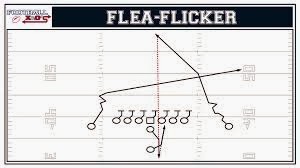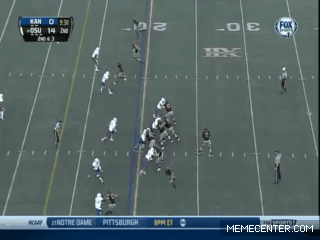ARIZONA WILDCATS - Zone Read + Flat
When one thinks of the triple option, they often think of the traditional flexbone and wishbone.
This is still used by a couple of college teams here and there, including the handful of service academies. But they're not the only ones running the triple option; many teams use the concept, just not in a way that you might immediately recognize.
Rich Rodriguez has long been considered an offensive guru in modern football. Not only is he given credit for accidentally inventing the shotgun zone read in a small divII college in West Virginia, but he was one of the first to combine a zone running game and a complementary screen game.
 |
| Stay classy, Richy |
Rodriguez uses the flat route, either with a bubble or a flare, to enhance the effectiveness of the running game.
Let's take a look at what I mean by this: here, the play combines an inside zone read with two slot screens. Both of them are pre-snap reads, but the play-side bubble also acts as a post-snap option for the quarterback. Let's simplify it and go through all of the scenarios: if either of the inside corners (inside the dotted circle/circle+square) show blitz or play way off of their respective receivers, the quarterback will take the snap and throw to that respective receiver, who is running a bubble. If they're playing close, then the quarterback is finished with his pre-snap reads. After the ball is snapped, if the play-side defensive end (in the dotted square) stays put when the quarterback puts the ball in the halfback's belly, the qb hands the ball off and carries out his fake, hoping to influence either the linebacker or that defensive end towards him, leaving a hole for the halfback to run through. If the end crashes, the quarterback pulls the ball out. Then if the corner (highlighted in the dotted circle+square) covers the bubble by the slot receiver all the way to the sideline, the quarterback has an open lane to run through. If that corner crashes on the quarterback, he flares the ball out to the uncovered receiver, hoping that the outside receiver properly executed his block.
I know what you're asking: "Wow, how in God's green earth can such an intricate play be ran on a consistent basis?!"
Well, it is, and quarterbacks have to go through reads like this for every play, so hopefully this will make you appreciate your favorite team's quarterback a little bit more. Unless you're a Jets fan. In which case, I'm sorry. Not for what I said, but for you being a Jets fan.
Now the marriage with the inside run and the bubble has been used by many, many teams, but the wham flat and the Y flat is something specific to the Wildcats.
The "wham" block is when an eligible receiver (not a lineman) blocks the back-side (in the shotgun, the play-side) defensive end, who is left unblocked by the offensive lineman. After a while, teams started using the same block on a zone read. Take a look at the diagram below.
 |
| If the end stays, the FB blocks him and the QB hands off; if he crashes, the FB climbs up and makes a seal block for the QB. |
Take a look at it used by the Cincy Bearcats
 |
| notice how the fullback blows up that unblocked defensive end |
here's a case where he pulls
 |
| end crashes, fullback moves up to block the first man in a blue jersey |
Now Rodriguez altered the concept slightly, with a fullback or tight end running a flat route instead of a slot receiver.
Here, the fullback runs off of the butt of the tackle and releases into the flat. It's a new variation off of the triple option.
Here's where the flat is uncovered
 |
| 'backer crashes, tight end left open |
and here's where it is covered
 |
| DE crashes, linebacker covers TE, opening a running lane by the QB |
Even after a 7-5 season, the Wildcats are a team to watch going into next season, for their schemes if nothing else. I also watch them for their unique uniforms, but that isn't usually a common reason to watch a football game.
Well, that wraps it up for this lesson, and hopefully you're not too bored out of your mind. Also, a message from captain hindsight - this post might have not been great for all of you visual learners with slow wi-fi, the gifs helped demonstrate what I was talking about. But anyways, I hope you enjoyed this post (we're up to 2000+ viewers!) and have a happy, happy holidays, whether it be Christmas, Quanza, Festivus, or otherwise.
-TF





















































